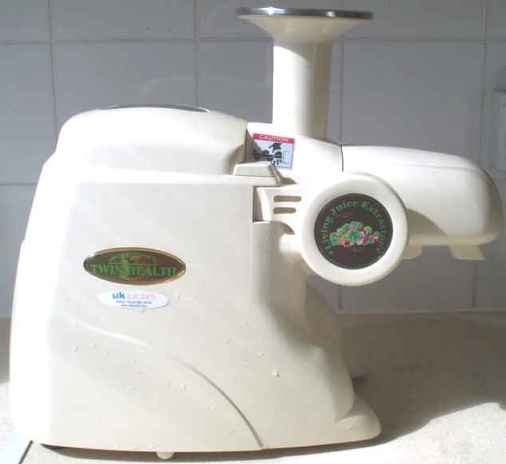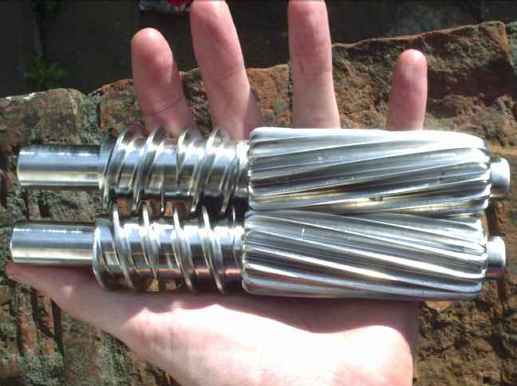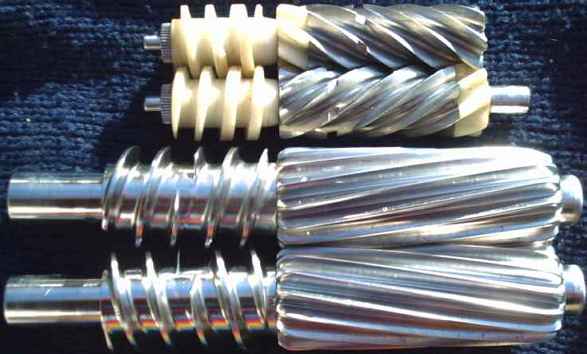Review After seeing my Samson Ultra review, [UK Juicers] kindly loaned me a sample of the Twin Health twin gear juicer for ten days for me to evaulate. This page describes the results of my examination of the machine. Manufacturer The Twin Health juicer is manufactured by [Woorideul] - a Korean company. The designer of the machine had been previously involved in designing the Angel juicer. The machine is a low-RPM, twin gear juicer. It is being marketed as being one of the best-quality machines available.
Synopsis This is another good twin gear machine. It has some interesting innovations. Hopefully some of these will form the basis of future designs. The machine uses huge stainless steel gears driven at a low rate of RPM by a powerful motor. A good deal of effort has been put into making the machine easy to clean. More screens are supplied with the juicer - including some high-quality fine vegetable and fruit screens that produce very good quality juice. However, there are not really any significant improvements in the volume of the resulting juice - and indeed, if the machine is used to produce small quantities of juice, the output appears to be reduced in volume compared to some of its competitors.
Comparison with Samson Ultra Comparisons with Samson Ultra are inevitable - given this is probably the machine's closest competitor. I've been in the fortunate position of having both the Twin Health and Samson Ultra available to me at the same time - and so am in a good position to compare them. I ran a number of tests to compare yields from the two machines under a variety of conditions. You can see the results on the page of juicer tests. The machines have some significant differences. The gears are an obvious difference. As the photo above illustrates they differ dramatically in size and design. Not everything was covered by these tests - so here are some more comments:
The build quality on the Samson machine seems to be generally better. Certainly the effort made on engineering the gears looks as though it dwarfs the R+D behind the huge-but-very-simple Twin Health gears. The Twin Health machine's approach involves a few bright ideas - and some application of some idea about bigger being better and the greater force winning out. Screens While a lot of effort looks like it has gone into the design of the Samson screens, and their reinforcement, the Twin Health screens look more like razor spare parts that have been knocked into shape. However overall, the Twin Health screens are a significant plus point for the machine. Although there is not so much screen up against the point of highest pressure, the screens all face downwards (eliminating a fair bit of waste in the process). They are more modular, are probably a lot cheaper to build, supply and replace. They seem more flimsy than the Samson screens, but they are probably strong enough - and if they do eventually break, replacement is likely to be a possibility. The smaller holes of two of the Twin Health screens result in better filtering of the fibre from the juice, and smoother, more palatable juice - a significant positive point for the machine. Gear size An obvious difference between the machines is the size of their gears. The Twin Health gears weigh almost five times as much as those of the Samson Ultra. They are huge. The large gears have several undesirable side effects - their wider diameter increases the speed with wich their cutting surfaces move - effectively undoing most of the desirable aspects of using a somewhat lower RPM. Similarly the force at the tips of the teeth is similarly diluted - necessitating a more powerful motor. The greater gear surface area of the Twin Health machine results in more friction - and a larger region inside the machine where produce can be wasted. Maybe the larger gears are the result of empirical testing. However other manufacturers do not seem to have seen fit to use them. I'm very sceptical about their benefits. I suspect they are either a marketing move - or simply a mistake. I would rather see longer gears than fatter ones. The costs of fatter gears seem to outweigh their benefits to me. Fat gears do result in making lower RPMs feasible - but that's almost entirely a marketing benefit - since damage to the produce has much more to do with the relative speed of the gear teeth than how many times a minute they are rotating. The gears are impressive looking. They certainly seem big and powerful. However, my impression is that they do more harm than good to the machine's functionality. Jams My tests suggested that the Twin Health machine is more likely to jam up than the Samson Ultra - despite the greater specifications of its motor. I don't like it when my juicer jams. With modern machines jams are probably harmless - but nontheless, I worry that the manufacturer's safety mechanism may not be doing its job properly - and that the overloading may result in damage to the machine's (expensive) motor. The sample Twin Health machine jammed twice on me in ten days. My Samson Ultra has only ever jammed once in about two years - and that was when feeding it frozen produce. Since I was juicing reasonably large volumes of produce for testing purposes, I do not regard these jams as being particularly likely to occur during normal use - and so don't think their presense should count against the Twin Health machine too much. Postscript to jam comments:
While protecting the motor of the machine seems like a good idea, I'm inclined to think the machine should still not jam solid when being fed test loads such as the ones I used. I currently have no impartial source of information about the mechanism the Samson Ultra uses to detect overloads. The one cut-out I experienced with it involved feeding it frozen produce - and apparently represented a sudden jam rather than a progressive over-loading - circumstances apparently not entirely consistent with the hypothesis of a cut out triggered by a sensor intended to detect overheating.
Many previous twin-gear machines have gone to a great deal of effort to enusure the stainless steel parts of the gears do not touch one another. Instead they have used nylon-on-stainless-steel - or nylon-on-nylon - as the means of driving the gears. The Twin Health machine represents a departure from this tradition - and uses a stainless-on-stainless drive mechanism. Is a metal-on-metal drive mechanism undesirable enough to go to the lengths of using nylon parts - and making sure that stainless steel never touches stainless steel? I've created a page of my views about the significance of the concern about using all-stainless-steel gears. Pressure regulation The Twin Health machine uses a "simple and inexpensive" means of pressure regulation. It forces the pulp through a small hole, partially sealed by a piece of rubber. As pressure builds the piece of rubber bends - creating a small hole for the pulp to pass through. The resulting mechanism is very simple - and is also very easy to clean. It is not very adjustable. Adjusting it involves unscrewing the piece of rubber and screwing in another piece which has a different degree of flexibility. It isn't very clear to me how effective the mechanism is at creating high pressures inside the machine. How durable the mechanism is isn't immediately obvious, either. Replacing the bits of rubber would be simple - provided some spares are supplied. I apparently received no spare bits of rubber with my test machine, though. Miscellaneous I slightly preferred the big red switch used on the Samson Ultra to the Twin Health's electronic buttons. However I did like the fact that the Twin Health controls were accessible from either side. I normally have to operate the Samson Ultra in a position where the switch faces away from me - and this is not very good. The Twin Health has no carrying handle. This was a right pain during the testing - since I was constantly moving the machines around. This might be a big deal to you. Or it might make practically no difference. I rejected the jugs on both machines and used Pyrex containers instead. The Twin Health jug is rather well designed, though - a definite plus point if you plan on using it. The Samson Ultra machine came with two "pushers" - one of which had a base which moulded itself to the twin gears and a "stopper" preventing it from being pushed in too far. While I rejected the supplied pushers on both machines (and made my own out of bits of wood), the Samson Ultra was probably better-equipped in this department. Ground clearance of the Twin Health machine had higher ground clearance than the Samson Ultra. This may be relevant if you plan to use your own containers. While both machines could still be fairly-easily be improved in this area, the issue is more urgent with the Samson machine. I have my Samson machine permanently raised up on large rubber feet. The distance of the body of the machine to the fibre outlet was smaller on the Twin Health machine. This is again relevant if you plan to use your own juice containers. Both machines could be improved significantly in this area. I probably won't be entirely satisfied until the pulp exit is brought out flush with the front end of the machine. The Twin Health machine took some effort to channel the juice outlet down into a narrow location - facilitating output directly into a narrow glass. Some people might appreciate this feature - but the screens opening directly downwards (with some minimal splash guards) would have been fine by me. The distance between the juice and pulp outlets was "adequate" on both machines - though greater separation might help a bit. Assembly and disassembly times were comparable on the two machines. The Samson Ultra required the pressure-control knob to be screwed and unscrewed - but assembling the gears and the screens on the Twin Health machine took slightly more effort. Both machines are made in Korea. While this probably makes Korea the twin gear capital of the world, it means that there is probably little basis for distinguishing the machines on nationalisitc grounds. Both machines had produce clogs - where material "backed up" in the feed chute. If anything, the Twin Health machine seemed to be slightly worse than the Samson Ultra machine in this respect. The machines fibre outputs differ significantly. The Twin Health machine always spits out a rectangular stream of fibre - while the Samson Ultra can spit out fibre as fine particles sometimes. While the neatness of the Twin Health output produces a positive first impression, close examination of the pulp tended to confirm what my juice yield studies showed - the Twin Health pulp was often not quite as dry as that that output by the Samson Ultra machine. I am happy to see that the Twin Health machine has completely dispensed with one of the Samson Ultra's more dubious selling points: magnetised gears. Though it's a very minor point, I also aprove of the simple, uniform close-packed screen patterns used in the Twin Health machine. The reputation of the manufacturer may enter into people's decision about which machine to use. My impression is that Samson will probably win here for most people - through being larger and better known. Twin Health problems? The Twin Health machine sample exhibited a couple of "faults" while in use.
Conclusion The Samson machine reached the market first. Consequently the machine has given me several years of trouble-free service - a point I regard as being of considerable significance. The Twin Health machine might prove to do the same - but I have no way of knowing that at this stage. The Twin Health manufacturers have had the luxury of seeing the its competition - and being able to take aim at its weaknesses. The Twin Health manufacturers have done a good job of making improvements in some areas. In particular, the easier cleaning, finer screens and less frothy juice are all welcome improvements. However the generally-slightly-lower juice yields I witnessed did not incline me towards switching to using the machine. Also the test machine's fan problem - and the fact that it jammed more than once during my testing - did not help produce a positive impression. I'm not sure the results are convincing enough to convince people such as myself to whole-heartedly embrace the new machine. However the machine seems to be being marketed quite well. It does have some technical merits - which should ensure it a reasonable degree of success. The overall design has some very attractive elements. Hopefully the machine will serve as a good foundation for future efforts. More competition for Samson will be welcomed in some quarters - and hopefully this machine will provide some of that. Design recommendations In case anyone is interested, I have listed some of my recent thoughts about the design of this sort of juicer here.
Gallery I took many photographs of the machine, and have created a gallery from the resulting images. Misc properties
Links
Manufacturer UK suppliers Related machines
Angel juicer types
|



